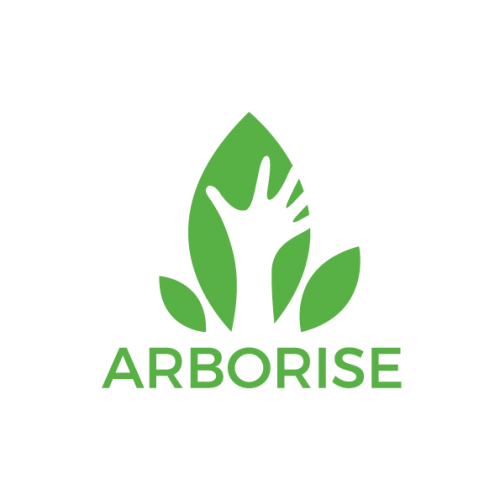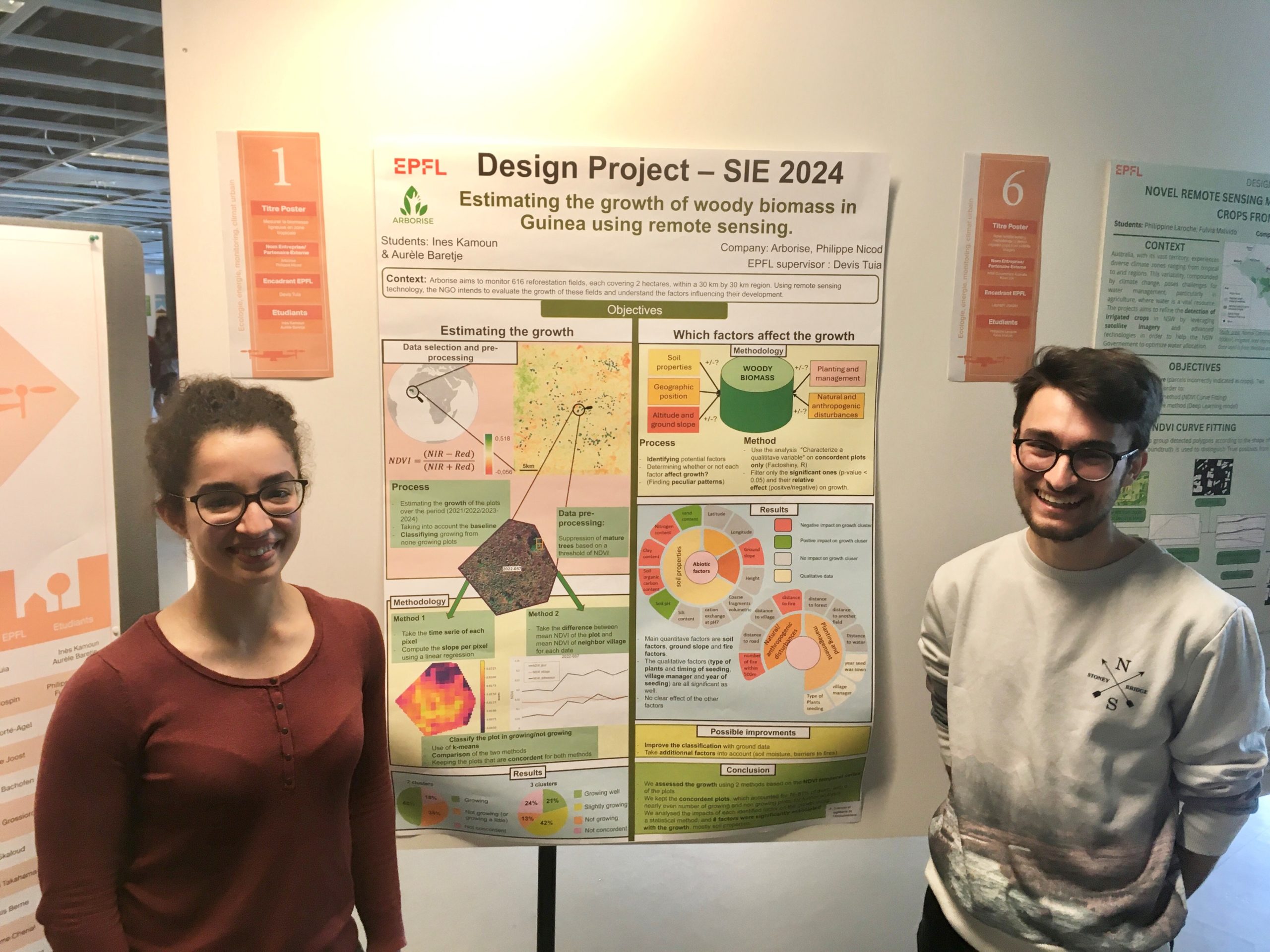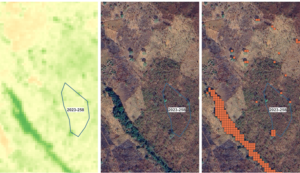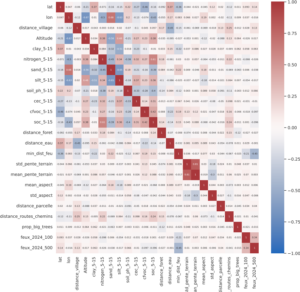How much CO2 does a forest absorb per year in the project area? This is the key question that all reforestation projects must answer in order to obtain certification and attract donors.
The simplest solution is to rely on scientific studies that have measured biomass growth in similar forests. The problem: very few articles on African forests have been published on this subject. Fortunately, the Hérault et al. research team has quantified the growth of several of our project’s tree species in the Korhogo region of Côte d’Ivoire, 400km from our project, over 30 years (The long-term performance of 35 tree species of sudanian West Africa in pure and mixed plantings).
Another, more precise approach is to measure the biomass of mature forests in the project area, and then deduce annual growth. This is what we have done with our partner EcoAct.
Before we can begin, we need to accurately identify the age of the forests to be measured. The objective is to know the average biomass growth per year and per hectare. To do this, EcoAct identified all the 20-year-old forests and all the 10-year-old forests in the Samana sub-prefecture. We then applied a number of additional selection criteria to obtain forests with little degradation and easy access.


Thanks to this pre-selection, we were able to identify the GPS points of 5 forests of 10 years and 5 forests of 20 years (knowing that we would only have time to measure four of each category).
On site, it’s not advisable to go into a forest alone, especially if you’re a foreigner. It is more respectful and prudent to make yourself known to the authorities in the nearest village, to explain your intention, receive advice and be accompanied. These discussions can be time-consuming, as there are also many questions about the project, but it’s well worth the effort. The support of the village is crucial.
Then it’s off to the forest. This often requires long approach walks, either in the bush or in the forest. The machete is essential for progress, and it’s best not to have forgotten anything in the vehicle (measuring equipment, raincoat, boots, water, etc.).
Once the GPS point had been reached, we marked out a 30m x 30m perimeter in each forest with tape, so that we knew exactly which trees to include in the measurements and which to exclude because they were outside the 900 m2 perimeter.
We then proceed methodically to make sure we don’t miss any trees. Specifically, one person measures the diameter at breast height, one person measures the height, one person indicates the species and marks the tree, to avoid re-measuring it a second time, and one person records this information. To recognize species, we need to rely on local expertise.


In the end, we measured over 1,500 trees in six days on 13 plots of land (in addition to the 4 10- and 20-year-old forests, we also measured trees on land to be reforested by arboRise in 2021 and 2022). It’s tedious work and not without risks, sometimes in the rain and in overgrown vegetation, but it’s essential work that will enable us to accurately calculate the biomass, and therefore the carbon, and therefore the potential income from the project, and therefore the possible expenditure.
Thank you Stéphane, thank you Julia for your strong engagement in the field under difficult conditions ♥
This initial overview of the forests has given us some tentative indications:
- Species diversity depends on the soil: some 20-year-old forests were almost monospecific, with Uapaca Somon dominating, like beech in temperate forests, at the expense of all other species. This should encourage us to carry out targeted thinning to maintain biodiversity.
- On the sites reforested in 2021 and 2022, there is great variability in terms of density: it can reach more than 4,500 stems per hectare, but some parts of the plots are still bare 2 years after seeding. This is due to the soil.
- The same 10-15 pioneer species are almost always found, and we can assume that natural regeneration is effective. This should encourage us to focus seed collection on the rare species on our list of 40 species.
Once the data has been collected, the analysis work can begin. Silviculturists and forestry specialists long ago learned how to estimate the volume of a log (a delimbed trunk) when Europe was being deforested to build ships. Basically, it’s a matter of calculating the volume of a cylinder: Pi x radius2 x height. In reality, a trunk is not really cylindrical, but rather conical. And the proportions between diameter and height vary depending on the type of forest (temperate, tropical, boreal, dry, humid, rainforest, etc.). This is why numerous studies have attempted to find the allometric equation that most closely approximates a given forest type. Some even try to include branch volume in the equation. It should be remembered that these equations are fairly reliable for monospecific cash tree plantations, but in natural forests made up of several species this quickly becomes approximate and generally underestimates the forest’s biomass volume.
With our partner EcoAct (thanks Margarita! ♥ ), we tested seven allometric equations, specific to tropical forests, and selected the equation whose correlation with the NDVI value of the GPS point was maximum: the equation of Djomo et al. (2010)* which considers diameter and wood density (as we couldn’t measure the height of all trees): B = exp(-1,8623 + 2,4023 ln(D) – 0,3414 ln(p))


These values indicate the weight of dry biomass. Then remove the weight of all non-carbon atoms (x 0.47), and add the weight of the two oxygen atoms (x 3.67) to obtain the weight of CO2 in the trunks of each hectare. To this, by convention, we add 20% to account for subterranean CO2, present in the roots.
We can thus say that, in the project area, the trees of a forest have absorbed 325 tonnes of CO2 per hectare after 20 years, i.e. 16 tonnes per year.
Since we have values for forests of 2, 3, 10 and 20 years, we can even estimate the growth curve:


It should be remembered that we’re dealing here with naturally regenerating forests, some of which have probably been degraded (for example, the biomass of one of the 10-year-old forests is significantly lower than that of the others). However, our garden forest approach should generate more diversified, denser and less degraded stands, with a greater quantity of biomass as a result.
We’ll talk more about this in a few years’ time, when we take the first dendrometric measurements of our forests. And in this regard, perhaps some of you can help us find Terrestrial Laser Scanning equipment, which will enable us to measure exactly the whole of a tree (not just the diameter at chest height and the height), so that we can include the CO2 absorbed by the branches, without going through an allometric equation. Thanks for your help !






